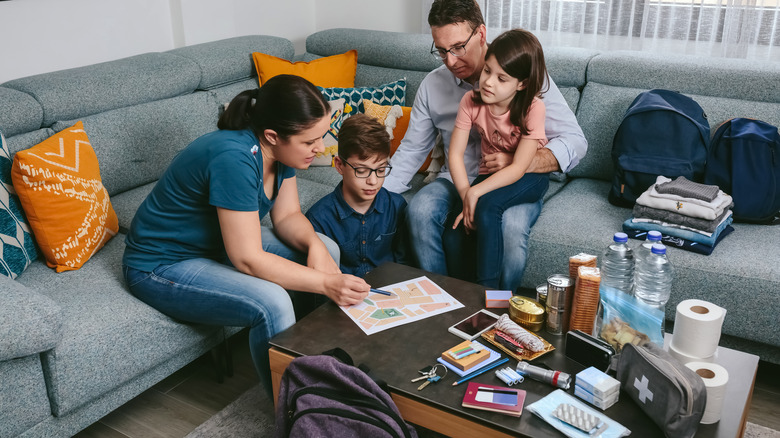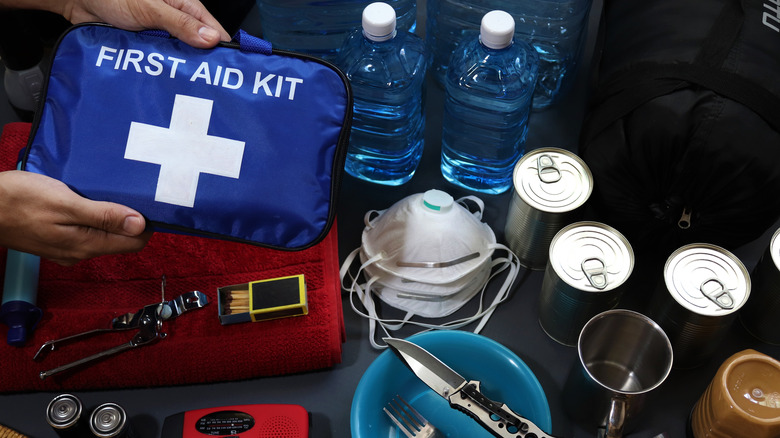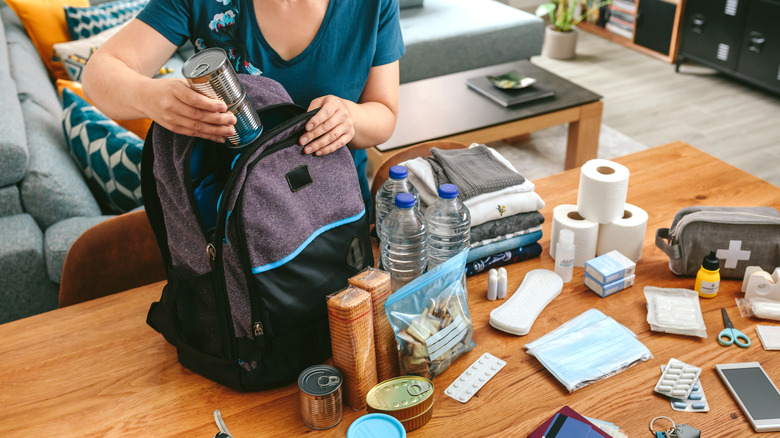How To Organize Your Emergency Kit And Supplies
Whether your area is prone to winter storms, tropical disturbances, fires, or floods, experts agree that every home should have an emergency kit. Each family member needs an evacuation bag as well. Assembling these necessities — whether you refer to them as emergency kits, disaster supply kits, or survival kits — helps families be prepared for any crisis caused by a disaster ranging from power outages to being stranded at home. Like insurance coverage, you hope you'll never need these things but will appreciate them if you do.
Basic emergency kits should be outfitted with enough core supplies to survive without assistance for several days, as noted on Ready provided by the U.S. Department of Homeland Security. Some resources, like The Prepared, believe planning for even longer durations, like weeks or months, is a good idea. What you include in a preparedness kit matters, but how you organize your supplies can also make a big difference in a crisis.
What to include in an emergency kit
Non-perishable food, clean water, and first aid supplies are essentials in an emergency kit. Ready-to-eat canned goods and a manual can opener are good places to start, along with individually packaged items like protein bars. The American National Red Cross suggests a three-day food supply for evacuation and enough to last two weeks at home. Water supplies at home should cover one gallon daily and per person for at least two weeks. A well-stocked first aid kit should have a variety of sterile bandages, antiseptics, gauze, adhesive tape, a rubber tourniquet, cold packs, cotton swabs, and even super glue, among other suggestions, according to the Mayo Clinic.
According to FEMA, other short-list emergency kit items include a flashlight with extra batteries to navigate in the dark and a battery-powered or hand-cranked radio to stay on top of emergency communications. Dust masks can also be helpful in times when air quality is poor, and a whistle is handy for signaling in search and rescue situations. Some other things you might not think of are local maps for navigation when cell phones don't work, a pair of pliers or a multi-tool, pet supplies, and activities for kids when the power is out, or you're forced to evacuate.
Organizing your preparedness supplies
Keeping emergency items stowed so you can get your hands on them when a crisis occurs is just as important as having them available. It may not be possible to keep everything in one place, but having most items close together in a dry, cool, and dark area is suggested by The Dixon Pilot. Closets and pantries are both options that work well. Consider grouping items like lighting sources, communication equipment, or medical supplies in stackable plastic bins with labels. Store needed batteries or accessories with each type of item. This makes it easy to grab and go when time is of the essence and to stay on top of expiration dates where needed. After all, you don't want to wait until you need your emergency radio to discover that you don't have the right batteries. Don't forget to prep your important documents for an emergency as well.
Having a go bag packed is a good idea, too. This is especially true if you know a disaster is impending. For instance, many people threatened by fires do this hoping they don't have to evacuate but are prepared if they do. The County of Sonoma Emergency Readiness, Response and Recovery team in California suggests making one for each family member with specific items they'll need while away, ranging from necessities like medications to small toys and games for children to keep them occupied and calm while away from home.


